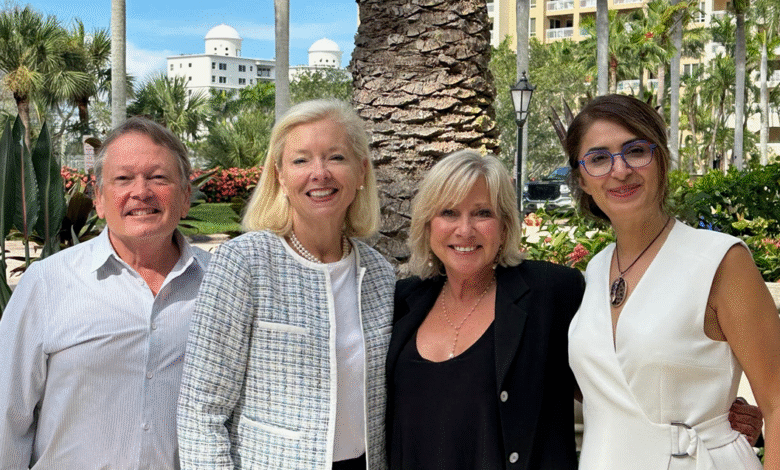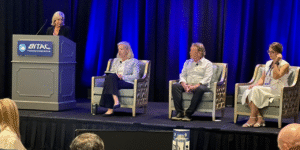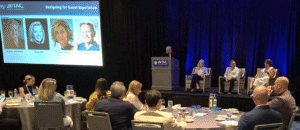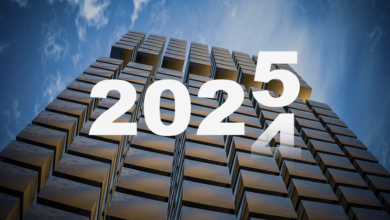
BITAC Purchasing & Design Summer 2025 Panel: Designing for the Guest Experience, Part 2
By Jim Nelson | November 7, 2025

BITAC, our sister company, produces many highly anticipated executive events each year, including the recent Purchasing & Design event. This gathering brings together hospitality leaders in the purchasing and design fields to network and deepen their understanding of their part of the industry. One of the featured panels at this event, “Designing for the Guest Experience,” focused on enhancing guest satisfaction through thoughtful design.
Moderator Brenda Amsberry, the principal and senior interior design director for OLC (Architecture | Interiors | Aquatics), was joined by panelists Cara Hall, principal at GH2 Architects; Vanisa Saffari, principal and interior designer at Porada Design Group; and Todd Voelker, president/owner of Voelker Gray Design and T S Voelker Architecture.
In part 1 of this article, the panelists discussed balancing brand standards, local culture, wellness, and adaptability to create unique, comfortable, and engaging guest experiences that foster connection, well-being, and “Instagrammable” moments.
BRENDA AMSBERRY: There’s a hotel in Denver called the Catbird Hotel, designed and run by Sage Hospitality, who are always very cutting-edge in their enterprises; they have something called Yoga Social on the rooftop. I’ve attended it a few times, and guests and locals alike will meet for yoga on the rooftop, amazing views of the mountains, and live music. And after yoga, there’s a bar right next door, and we go enjoy getting to know each other. So, just thinking out of the box and doing things that haven’t been done before, a way of bringing people together and letting us laugh and be funny and silly. I love the saying, “We’re all weird. It just depends on how much you show it,” so be weird. Be yourself, laugh. Don’t take yourself too seriously. With that, we’re going to conclude with the challenges that you’ve come across trying to implement different things that are out of the box.
CARA HALL: We’re finding that not only is there a product delivery timeline problem, but the brands are not keeping their timelines. We need to build in extra time that no one planned on. Some of the other challenges that we’re having are the timelines that it takes when you have to apply for a waiver to use local artwork or a more appropriate material to the climate or flooring materials, and things like that. We’re working on projects in South America, and it’s become more norm in the United States as well, the flooring is not carpeting. It can’t be, and that’s a waiver for some reason, even in a climate when you shouldn’t have draperies and carpet. So those are just some specific examples of some of the challenges we’re running up against.
TODD VOELKER: One of our largest challenges is dealing with governing agencies. I don’t know what happened. It seems like everybody at the schools is teaching planners how to just check boxes, instead of thinking critically about imagining what could be: “But I don’t see a box for that.” So, it’s very upsetting to them. And unfortunately, it’s very expensive, especially on the front end. We do a lot of master planning of resorts, and it’s really hard because the rules are there for a good reason, for the most part, but I think that there’s a lot of young bureaucrats that think it’s their job to stop everything, unfortunately. I could be speaking from California more than anything, but it may be everywhere. It’s very frustrating and it really affects the economy because we operate two years in advance, generally speaking, plus or minus. Right now, I’m busier than I’ve ever been and we’re up for our second best year ever. I’m an optimist, and yeah, there’s all these things that are stop signs. I’m not saying that bad things are not going on in the world; certainly, there’s challenges, but we choose not to dwell there. My clients, thankfully, are of the same like; that’s why we work together. We see beyond that, and we’re trying to imagine a better world once we all get through all of this craziness, and let’s just get on, create more jobs, open some fantastic projects that unite people so we can all feel good together again and not hide in our rooms.
VANISA SAFFARI: I think the FF&Es delivery times are really stretching. It used to be, for example, eight weeks, 10 weeks of lead time; now it’s so prolonged that it’s affecting everything: all your planning; the installation dates, your project; turnovers, and the staffing. So that is something that is affecting our process, especially the things that are coming from, for example, overseas; from China, from Vietnam. At the end of the day, you have a deadline, and you are behind.
CH: We’re trying to do two competing things: create a sense of community and belonging and togetherness, and at the same time we have significant security concerns. It’s almost always our job to work out the front end of that, the installed part of that, making sure that we provide a secure environment as architects and designers, but not lose sight of the humanity of it, creating places where people want to be together, and feel that openness and community together.
 BA: Community is everything. In fact, I think that’s the problem with a lot of the youth that are troubled is they don’t have a sense of place or community. So, getting a little altruistic here, it’s our job to help create that; we’re all humans, and so be human.
BA: Community is everything. In fact, I think that’s the problem with a lot of the youth that are troubled is they don’t have a sense of place or community. So, getting a little altruistic here, it’s our job to help create that; we’re all humans, and so be human.
TV: It’s defining what could be, and being creative with that, and then designing the space to support that, as authentic and as immersive as it can be to support that concept, whatever that is. And then people go, “My gosh, where am I? This is amazing.” It sort of wakes up the senses. We are social people, and we want that connection, we want to feel good again and support the body and be healthy through what your amenities offer, and also support your psychology of connection, and comfort and peace of mind.
VS: The trick is to design spaces to avoid forced interactions and create common curiosities.
BA: We forget about our inner child. Everything we design with the children really encourages exploration and curiosity, and we tend to lose that when we get older.
TV: Children naturally want to play, and they just want to get together and have fun. Adults do too, and we need to connect with that. I love the wine and painting, which is a big thing a lot of the places are doing; we’re doing it in all our spas. Or creative pottery making. We’re inner artists; everybody needs a box of Crayolas, and I think the world would be happier.




Get involved!
Comments